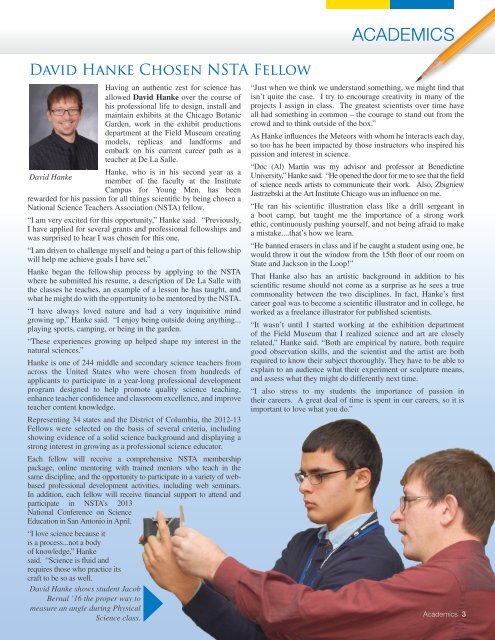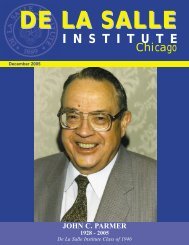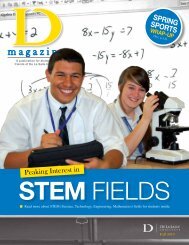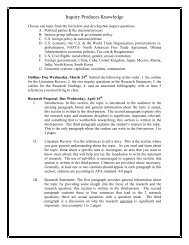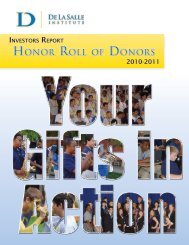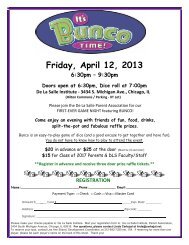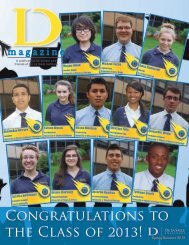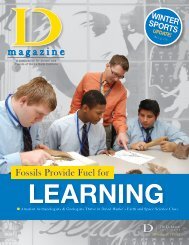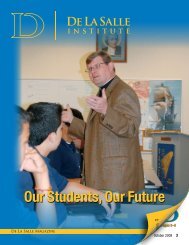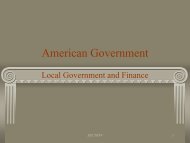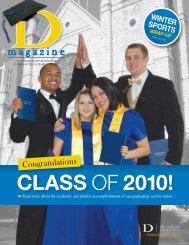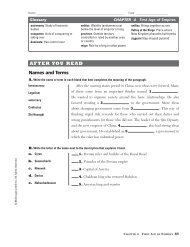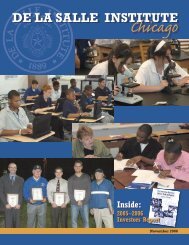Winter 2013 Issue - De La Salle Institute
Winter 2013 Issue - De La Salle Institute
Winter 2013 Issue - De La Salle Institute
- No tags were found...
Create successful ePaper yourself
Turn your PDF publications into a flip-book with our unique Google optimized e-Paper software.
David Hanke Chosen NSTA FellowHaving an authentic zest for science hasallowed David Hanke over the course ofhis professional life to design, install andmaintain exhibits at the Chicago BotanicGarden, work in the exhibit productionsdepartment at the Field Museum creatingmodels, replicas and landforms andembark on his current career path as ateacher at <strong>De</strong> <strong>La</strong> <strong>Salle</strong>.Hanke, who is in his second year as aDavid Hankemember of the faculty at the <strong>Institute</strong>Campus for Young Men, has beenrewarded for his passion for all things scientific by being chosen aNational Science Teachers Association (NSTA) fellow.“I am very excited for this opportunity,” Hanke said. “Previously,I have applied for several grants and professional fellowships andwas surprised to hear I was chosen for this one.“I am driven to challenge myself and being a part of this fellowshipwill help me achieve goals I have set.”Hanke began the fellowship process by applying to the NSTAwhere he submitted his resume, a description of <strong>De</strong> <strong>La</strong> <strong>Salle</strong> withthe classes he teaches, an example of a lesson he has taught, andwhat he might do with the opportunity to be mentored by the NSTA.“I have always loved nature and had a very inquisitive mindgrowing up,” Hanke said. “I enjoy being outside doing anything...playing sports, camping, or being in the garden.“These experiences growing up helped shape my interest in thenatural sciences.”Hanke is one of 244 middle and secondary science teachers fromacross the United States who were chosen from hundreds ofapplicants to participate in a year-long professional developmentprogram designed to help promote quality science teaching,enhance teacher confidence and classroom excellence, and improveteacher content knowledge.Representing 34 states and the District of Columbia, the 2012-13Fellows were selected on the basis of several criteria, includingshowing evidence of a solid science background and displaying astrong interest in growing as a professional science educator.Each fellow will receive a comprehensive NSTA membershippackage, online mentoring with trained mentors who teach in thesame discipline, and the opportunity to participate in a variety of webbasedprofessional development activities, including web seminars.In addition, each fellow will receive financial support to attend andparticipate in NSTA’s <strong>2013</strong>National Conference on ScienceEducation in San Antonio in April.“I love science because itis a process...not a bodyof knowledge,” Hankesaid. “Science is fluid andrequires those who practice itscraft to be so as well.David Hanke shows student JacobBernal ’16 the proper way tomeasure an angle during PhysicalScience class.ACADEMICS“Just when we think we understand something, we might find thatisn’t quite the case. I try to encourage creativity in many of theprojects I assign in class. The greatest scientists over time haveall had something in common – the courage to stand out from thecrowd and to think outside of the box.”As Hanke influences the Meteors with whom he interacts each day,so too has he been impacted by those instructors who inspired hispassion and interest in science.“Doc (Al) Martin was my advisor and professor at BenedictineUniversity,” Hanke said. “He opened the door for me to see that the fieldof science needs artists to communicate their work. Also, ZbigniewJastrzebski at the Art <strong>Institute</strong> Chicago was an influence on me.“He ran his scientific illustration class like a drill sergeant ina boot camp, but taught me the importance of a strong workethic, continuously pushing yourself, and not being afraid to makea mistake....that’s how we learn.“He banned erasers in class and if he caught a student using one, hewould throw it out the window from the 15th floor of our room onState and Jackson in the Loop!”That Hanke also has an artistic background in addition to hisscientific resume should not come as a surprise as he sees a truecommonality between the two disciplines. In fact, Hanke’s firstcareer goal was to become a scientific illustrator and in college, heworked as a freelance illustrator for published scientists.“It wasn’t until I started working at the exhibition departmentof the Field Museum that I realized science and art are closelyrelated,” Hanke said. “Both are empirical by nature, both requiregood observation skills, and the scientist and the artist are bothrequired to know their subject thoroughly. They have to be able toexplain to an audience what their experiment or sculpture means,and assess what they might do differently next time.“I also stress to my students the importance of passion intheir careers. A great deal of time is spent in our careers, so it isimportant to love what you do.”Academics 3


